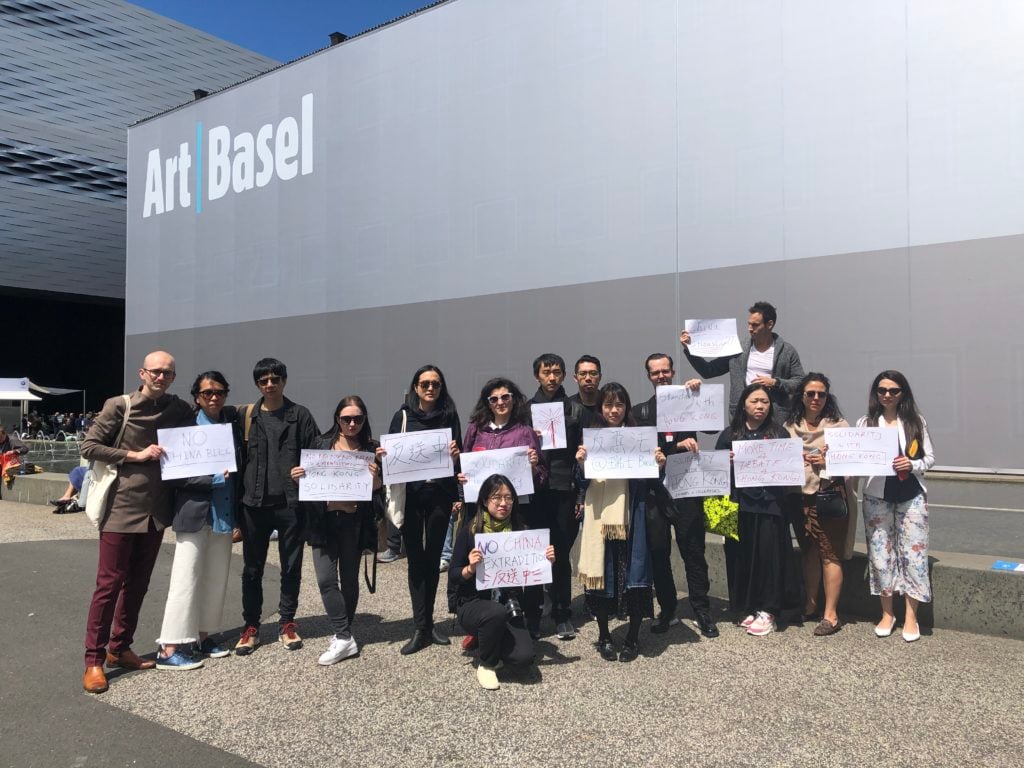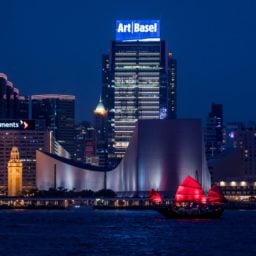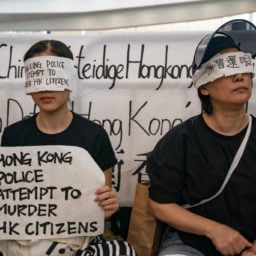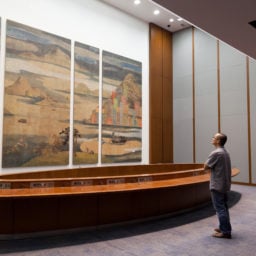At noon on June 12, as the Art Basel fair took place inside the giant convention center behind them, more than a dozen members of the Hong Kong art world—including gallerists, artists, and curators—gathered in the Messeplatz to stand in silence, holding handwritten signs that read: “No Extradition to China,” “Anti-Extradition Bill,” and “Support Hong Kong.” They said they were there to stand in solidarity with the city, which had just seen more than one million civilians taking to the streets three days earlier to protest against the proposed law that would allow suspects of any nationality living or traveling in Hong Kong to be extradited to mainland China for trial.
At the same moment that these demonstrators were expressing their message to the well-dressed art lovers entering the fair, tens of thousands of young protesters on the other side of the globe were marching in the streets to overturn the bill—only to be met by Hong Kong police who fired tear gas, beanbag rounds, and rubber bullets into the surging crowds. In Basel, the quiet handful of art professionals were allowed to make their point until a fair security guard gently asked them to move along.
It was the second VIP day of the marquee Swiss art fair, and to an outside observer the dealers who were striking multimillion-dollar deals at a dizzying clip inside and the political unrest in Hong Kong may have seemed to occupy vastly different worlds. But, in fact, many at Art Basel were keenly monitoring the situation in Asia—because it could directly affect their businesses in profound ways.
“We are watching this closely,” Marc Spiegler, the global director of Art Basel who in 2013 opened an edition of the fair in Hong Kong, said during the press conference in response to the recent events. As to whether the political situation on the ground will affect the future of Art Basel’s Hong Kong fair, as well as the Western art dealers who have built outposts in that city at great expense, Spiegler said: “It’s dangerous to speculate right now.”
Spiegler was right. Indeed, in the end, after one million people protested and the international community united in condemning the violent police response, Hong Kong chief executive Carrie Lam announced that the government would suspend the legislative procedure of the extradition bill. But that did not resolve the crisis.
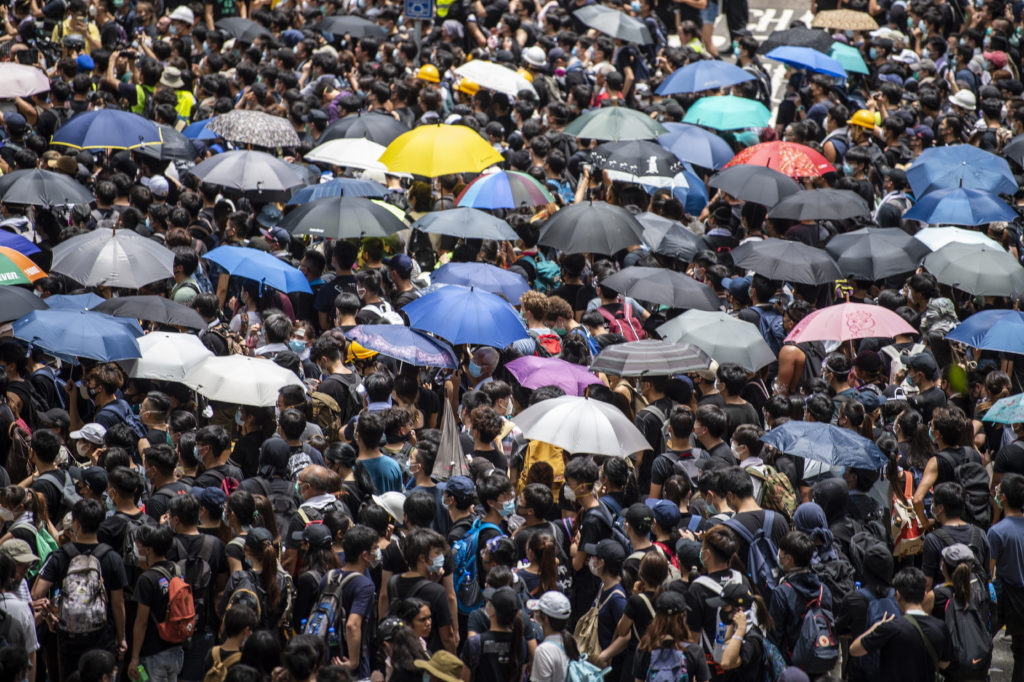
Protesters are seen occupying the streets in Hong Kong, China. 21 June 2019. Photo by Vernon Yuen, NurPhoto via Getty Images)
The following day, on June 16, two million people—more than a quarter of Hong Kong’s population—took to the streets, doubling the figure from the previous week’s protest. Some said they were angered by Lam’s refusal to apologize for proposing the bill, and they accused the police of using disproportionate force against protesters, who were largely university or even high school students.
The bill might have been suspended, but the crisis in Hong Kong is far from over. The tech-savvy, leaderless protesters escalated their actions on Friday, June 21, with thousands of black-clad youth surrounding the city’s police headquarters. Other actions are planned for coming weeks, including a June 27 demonstration in Osaka, Japan, ahead of the G20 summit, where US President Donald Trump is due to meet Chinese President Xi Jinping.
“I’m worried about the prospect of Hong Kong,” said one European gallerist who works with clients in Hong Kong and mainland China, and who requested anonymity. “Art is the first thing that people stop buying when there’s a major crisis.”
Is It Still Safe to Store Art in Hong Kong?
After the footage of Hong Kong police using force against mostly unarmed young protesters outside the government headquarters in Admiralty went viral during Art Basel, some international and mainland Chinese collectors at the fair were whispering about whether it would still be safe to keep their art stored in the city.
“I have been asked by my clients if they should move their collections to Singapore,” said one art consultant, who did not wish to be named. Another art advisor said at least a few collectors were considering whether the time was right to liquidate their collections.
Art, after all, is now treated as a class of financial assets. Events over the past weeks have sent shivers down the spines of people in Hong Kong and China—particularly wealthy individuals with large investments in the art market. Some tycoons are already taking action, moving their assets from Hong Kong to Singapore. According to a Reuters report, one had begun transferring than $100 million from a local Citibank account to another account with the bank in Singapore.
Even ordinary local residents who are not nearly as wealthy are seeking to move their money offshore, or are converting their savings in Hong Kong dollars into US dollars. Many were afraid that their assets in the city could be confiscated or frozen should the bill become law and they then are accused of breaking the law in China, or that something similar could happen in future.
Can Hong Kong Maintain Itself as a Tax-Free Haven?
Hong Kong has grown into one of the world’s most important art markets after New York and London, largely thanks to the major international auction houses and, in particular, to Art Basel, which since launching its Hong Kong edition in 2013 has served as a lucrative conduit for international galleries looking to expand their business to Asia—in the process grooming a new generation of affluent Asian art-lovers who are increasingly interested in Western contemporary art. Both the fair and the auctioneers take advantage of Hong Kong’s unique appeal, with its proximity to the vast market of mainland China alloyed with its freedoms and the independent judiciary stipulated under the “one country, two systems” principle.
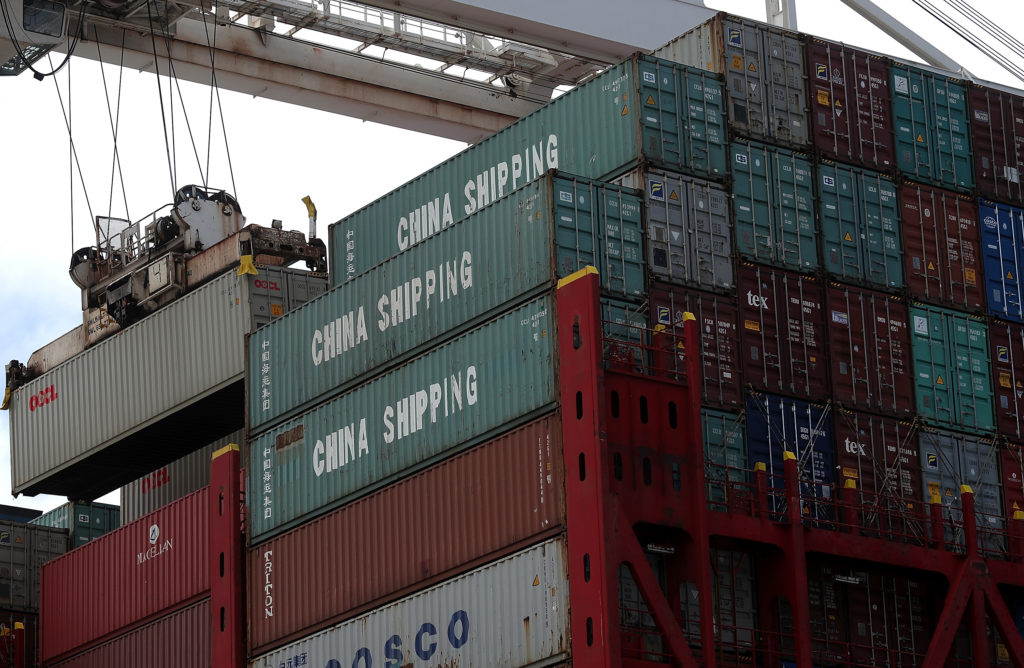
A shipping container is offloaded from the Hong Kong-based CSCL East China Sea container ship. Photo by Justin Sullivan, Getty Images
But what’s most important is the city’s freeport status. There is no import tax in Hong Kong, a stunning advantage compared to many other commercial hubs across Asia, particularly in mainland China, where hefty duties are applied to imported goods, including artworks. Although China has been continuously reducing the import duties it applies to art since 2012, artworks brought into China still incur at least an extra 16 percent cost of value-added tax in addition to import tax—among the highest in the world.
As a result, for those who do not want to pay extra duties, Hong Kong is a safe haven for art storage. Chinese media Artron estimates that there is $10 billion worth of art stored in Hong Kong at this moment.
The Low-Key Chinese Buyers at Art Basel
Fairgoers at Art Basel conveyed a collective impression that fewer Chinese collectors turned up for this edition of the Swiss fair compared to a couple of years ago. Notably, less Mandarin could be heard spoken in the aisles. According to sources close to the fair, some of the most recognizable attendees from China included: fashion mogul Li Lin, young real estate developer Lu Xun, car-dealership magnate Yang Bin, antiques dealer Zhao Youhou, and Shanghai nightclub impresario and Tanks founder Qiao Zhibing.
ShanghART founder Lorenz Helbling said there were definitely “great Chinese clients” on hand at the fair, “but they appear more individually, not in groups, so perhaps [they are] less visible for the public.” Lilian Wu, ShangART’s director, added: “We have seen more Southeast Asian collectors this year, especially from Thailand, Singapore, and the Philippines.”
For his part, Samuel Mizrachi of the Vienna-based Galerie nächst St. Stephan Rosemarie Schwarzwälder said he knew of “a few” Chinese collectors who attended the fair. “We are very successful in Hong Kong,” he said. “Maybe they buy more in Hong Kong instead of traveling all the way to Basel.” He also noted that he had met more collectors from other parts of Asia this year, including South Korea and the Philippines.
Some galleries reported sales to Chinese buyers, though many kept the specifics confidential. Lisson Gallery said it had sold an untitled Anish Kapoor painting to a Chinese private institution for £450,000 ($573,000).
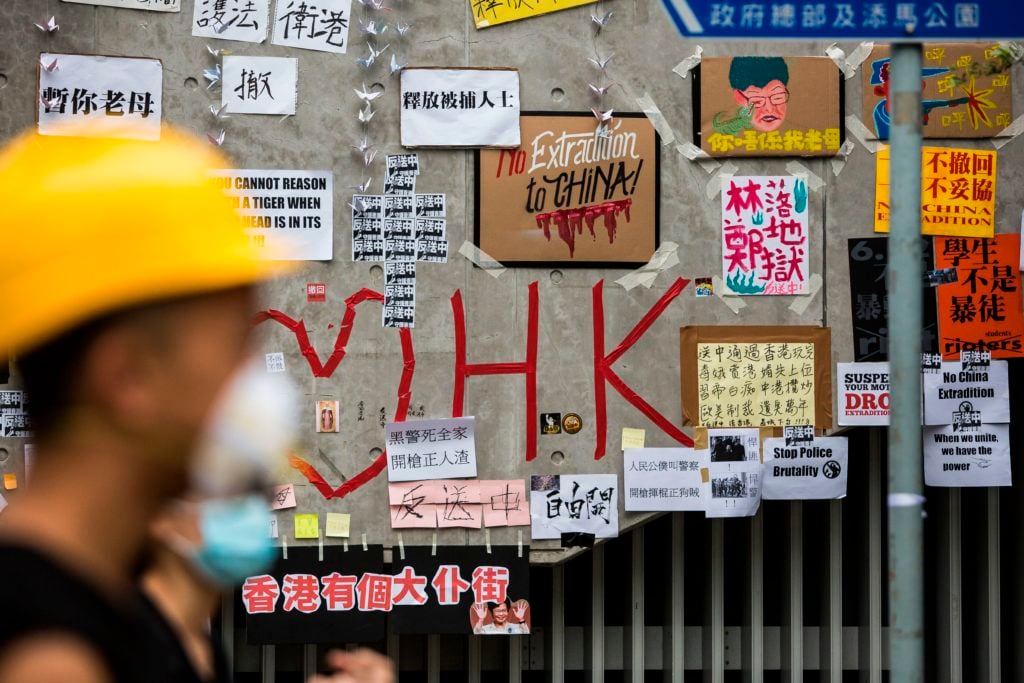
A wall of protester’s messages and posters in Hong Kong, June 17, 2019. Photo by Isaac Lawrence AFP/Getty Images.
The low-key presence of Chinese collectors this year could be the result of China further tightening capital outflow amid the ongoing trade war with the United States, several dealers suggested. Under Chinese law, citizens are allowed to transfer up to $50,000 overseas per year. But in reality, the limits can be even more stringent. It was recently reported that a former advisor of the People’s Bank of China, Yu Yongding, had been prevented from conducting a transfer of $20,000 abroad.
Last year, the high-profile case of Chinese celebrity Fan Bingbing, who was fined $129 million for tax evasion, sent a powerful signal to citizens to be wary in their financial dealings. Now, whereas top Chinese collectors often enjoyed generating headlines in the past, some now are trying to avoid the limelight while asking dealers to acquire art on their behalf and keep it outside of China, according market players with first-hand knowledge.
Hong Kong, as a result, has become more important than ever for those who wish to continue to work with Chinese clients. Dealers attending Art Basel said that, until now, the best way to store the artworks in such an arrangement would be to keep them in Hong Kong in order to avoid the taxes in mainland China and some parts of Europe.
America Is Stepping In
Britain might be the one that signed the Sino-British Joint Declaration with China, which guarantees Hong Kong’s sovereignty (until it expires in 2047), but recent events have given the United States a golden opportunity to gain the upper hand in the continuing trade war with China.
Although the Hong Kong government has suspended the extradition bill, fear that the city’s autonomy could vanish one day is palpable.
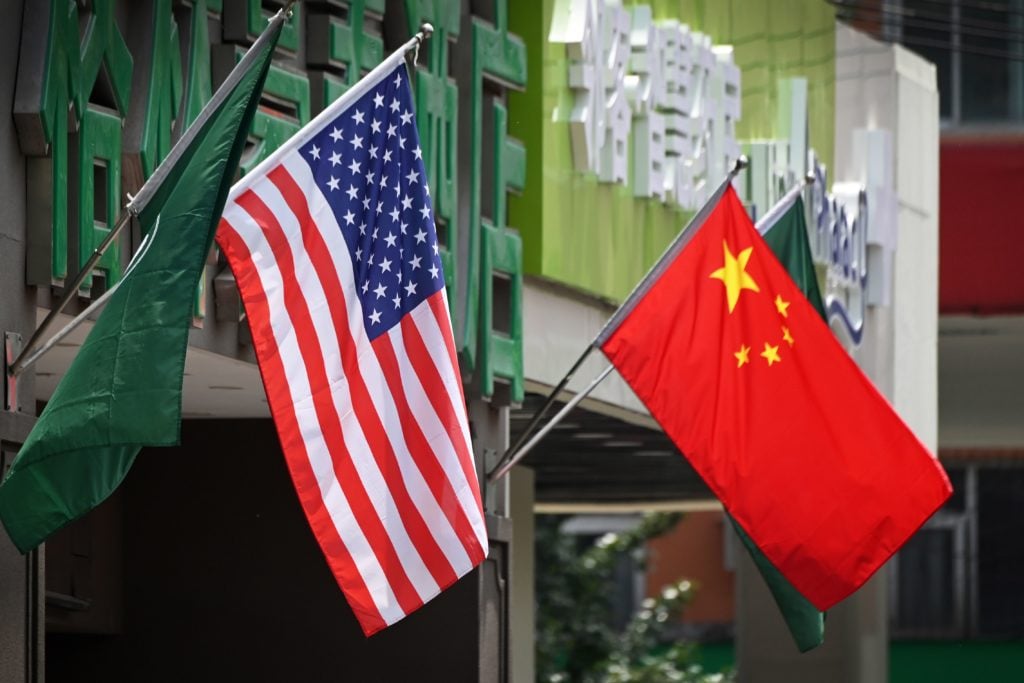
The US and Chinese flags are displayed outside a hotel in Beijing on May 14, 2019. Photo by Greg Baker AFP/Getty Images.
In 2003, Hong Kong’s mainland-aligned government pushed for the national security bill under Article 23 of the Basic Law, the territory’s mini-constitution, but the efforts were futile after 500,000 took to the streets to oppose the law that could restrain their freedoms. In 2012, nearly 100,000 marched to protest against the introduction of a national education curriculum. There is no guarantee the Hong Kong government will not put forth other laws and regulations that will curtail the city’s freedoms and the rule of law to please Beijing.
China insists that Hong Kong’s affairs are an internal matter, but the US doesn’t think so. The US-Hong Kong Policy Act of 1992 grants the former British colony special status, which allows exports from Hong Kong to escape from the tariffs applied to China. But amid recent developments, US senators led by Marco Rubio have introduced a bill to amend the 1992 act. Known as the Hong Kong Human Rights and Democracy Act of 2019, the harsh bill would allow the US Secretary of State to remove the special status of Hong Kong in response to the erosion of the city’s autonomy as Beijing tightens its grip over Hong Kong. US House Speaker Nancy Pelosi also backed the bill, saying, “The legislation says we no longer assume that China is operating under one country, two systems.”
Should the bill be passed and the trade war rage on, the temptation would be to remove Hong Kong’s special tax status—meaningfully chipping away at one of the key attributes that make it such an attractive marketplace for Western dealers and other businesses.
Simultaneously, art is back in the picture of the US-China trade war. In the Trump administration’s proposal for a new round of 25 percent tariffs applied to $300 billion of Chinese goods, works of art are again on the list. US President Trump said he would decide whether to proceed after his June 28 meeting with President Xi at the G20 summit. Trump is expected to also play the Hong Kong card by raising the recent protests to Xi during the G20.
How things will pan out remains to be seen, but many in the art world are hoping that Hong Kong’s status quo can be maintained despite the threats rising on both sides of the Pacific. “I just hope the world can see the pivotal position and advantages of Hong Kong as an art market,” said one dealer who works with mainland Chinese collectors.
Follow Artnet News on Facebook:
Want to stay ahead of the art world? Subscribe to our newsletter to get the breaking news, eye-opening interviews, and incisive critical takes that drive the conversation forward.
